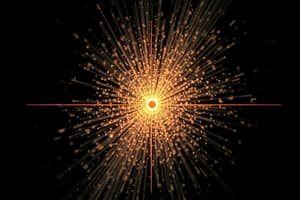Podcast
Questions and Answers
What distinguishes a vector quantity from a scalar quantity?
What distinguishes a vector quantity from a scalar quantity?
- A vector quantity has only magnitude.
- A vector quantity includes both magnitude and direction. (correct)
- A vector quantity cannot be added or subtracted.
- A vector quantity is always represented graphically.
Which of the following is an example of a vector quantity?
Which of the following is an example of a vector quantity?
- Mass
- Temperature
- Displacement (correct)
- Speed
Which statement about vector addition is correct?
Which statement about vector addition is correct?
- Vectors cannot be scaled by a scalar value.
- The length of the vector represents only its direction.
- The direction of a vector is irrelevant in addition.
- Vectors can be added in any order due to commutative property. (correct)
Which quantity describes the rate of change of an object's velocity and includes both magnitude and direction?
Which quantity describes the rate of change of an object's velocity and includes both magnitude and direction?
What is an essential characteristic of vector fields like electric and magnetic fields?
What is an essential characteristic of vector fields like electric and magnetic fields?
What is the primary function of heart valves?
What is the primary function of heart valves?
Which pathway correctly describes pulmonary circulation?
Which pathway correctly describes pulmonary circulation?
What happens during ventricular contraction concerning the atrioventricular valves?
What happens during ventricular contraction concerning the atrioventricular valves?
Where does the blood flow after it leaves the left ventricle?
Where does the blood flow after it leaves the left ventricle?
Which structure prevents backflow into the ventricles during diastole?
Which structure prevents backflow into the ventricles during diastole?
How does oxygenated blood return to the heart from the lungs?
How does oxygenated blood return to the heart from the lungs?
What is a potential consequence of malfunctioning heart valves?
What is a potential consequence of malfunctioning heart valves?
In systemic circulation, what is the primary role of the aorta?
In systemic circulation, what is the primary role of the aorta?
Flashcards
Vector Quantity
Vector Quantity
A physical quantity with both magnitude and direction.
Scalar Quantity
Scalar Quantity
A physical quantity with only magnitude, no direction.
Vector Example: Displacement
Vector Example: Displacement
Change in an object's position, including the direction of movement.
Vector Example: Velocity
Vector Example: Velocity
Signup and view all the flashcards
Vector vs. Scalar Importance
Vector vs. Scalar Importance
Signup and view all the flashcards
Heart Chambers
Heart Chambers
Signup and view all the flashcards
Right Heart Function
Right Heart Function
Signup and view all the flashcards
Left Heart Function
Left Heart Function
Signup and view all the flashcards
Cardiac Cycle
Cardiac Cycle
Signup and view all the flashcards
Heart Valves
Heart Valves
Signup and view all the flashcards
Atrioventricular (AV) Valves
Atrioventricular (AV) Valves
Signup and view all the flashcards
Semilunar Valves
Semilunar Valves
Signup and view all the flashcards
Pulmonary Circulation
Pulmonary Circulation
Signup and view all the flashcards
Systemic Circulation
Systemic Circulation
Signup and view all the flashcards
Study Notes
Definition of Vector Quantities
- A vector quantity is a physical quantity that has both magnitude and direction.
This contrasts with scalar quantities, which only have magnitude.
- Vectors are often represented graphically by arrows, where the length of the arrow represents the magnitude and the direction of the arrow indicates the direction of the vector.
- The magnitude of a vector is a scalar value representing its size.
- Vectors obey strict mathematical rules for addition, subtraction, and scaling (multiplication by a scalar).
Examples of Vector Quantities
- Displacement: The change in position of an object, indicating both how far and in what direction it moved.
- Velocity: The rate at which an object changes its position, including both speed and direction.
- Acceleration: The rate at which an object changes its velocity, so it includes both magnitude (how quickly) and direction (which way it is changing).
- Force: A push or pull on an object, having both a strength (magnitude) and a direction.
- Momentum: The product of an object's mass and velocity, requiring both a magnitude and a direction for a complete description.
- Electric and Magnetic Fields: These fields have both a magnitude and a direction at every point in space.
- Angular velocity: Rate of change of angular position.
- Angular acceleration: Rate of change of angular velocity.
Distinguishing from Scalar Quantities
- Scalar quantities, in contrast, only have magnitude and no direction.
- Examples of scalar quantities include mass, temperature, speed, and time.
- The difference between a scalar and a vector is crucial in many physics and engineering applications because ignoring direction can lead to inaccurate or nonsensical results.
Studying That Suits You
Use AI to generate personalized quizzes and flashcards to suit your learning preferences.




